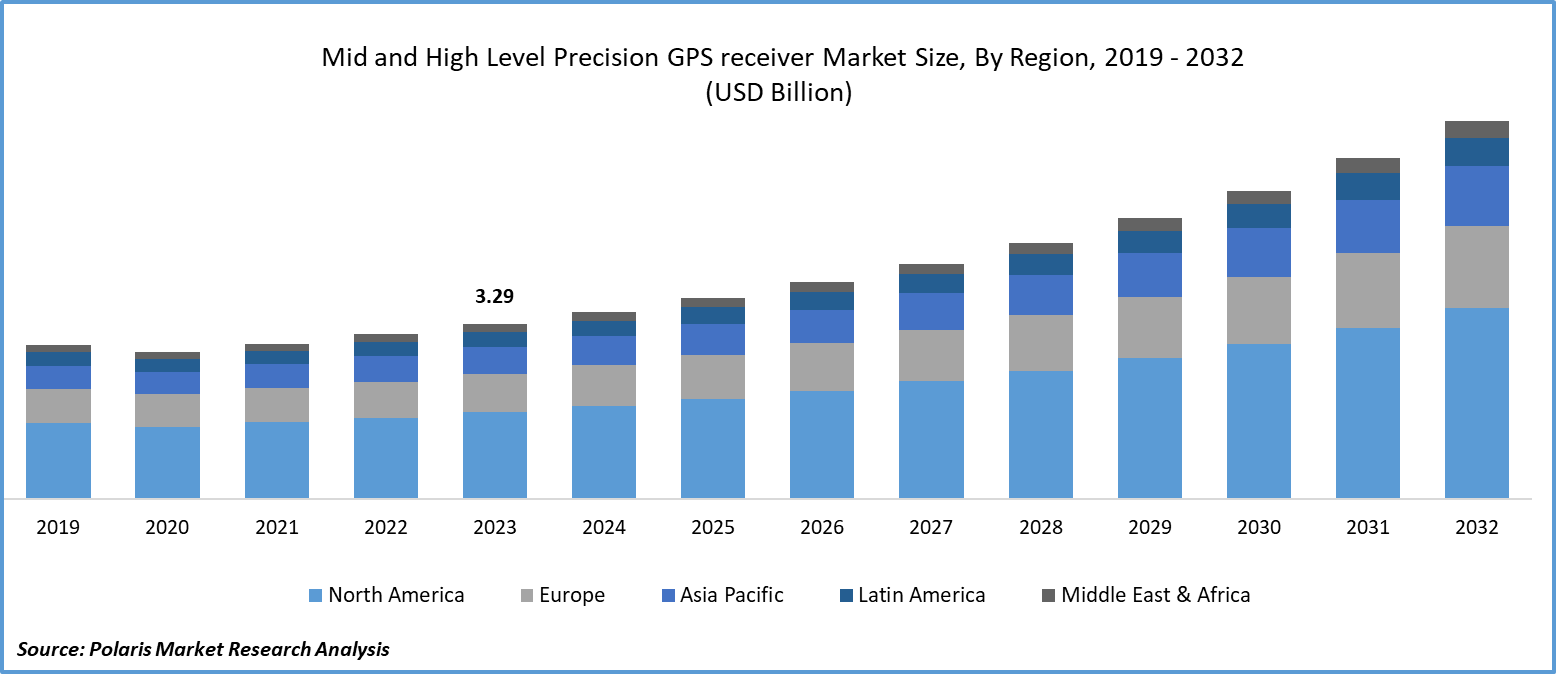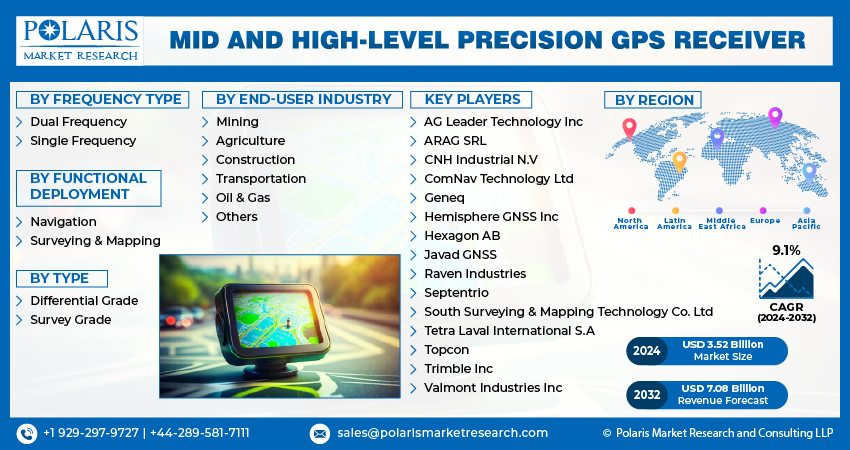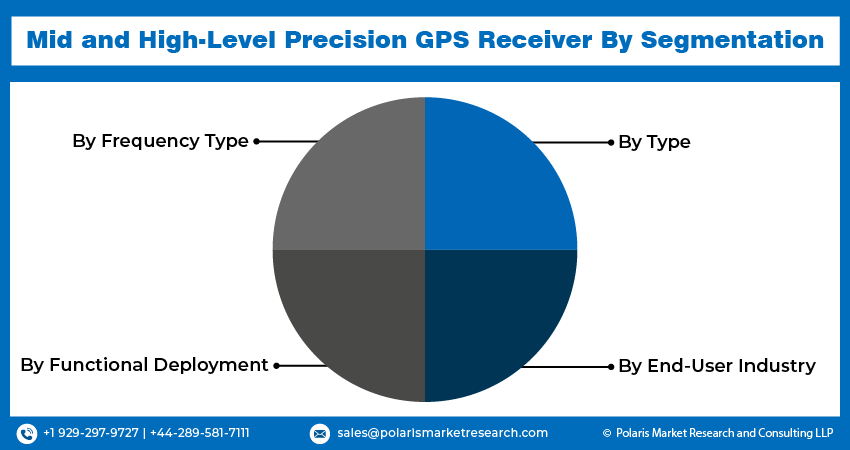
Mid and High-Level Precision GPS Receiver Market Share, Size, Trends, Industry Analysis Report, By Frequency Type (Dual Frequency, Single Frequency); By Functional Deployment; By Type; By End-User Industry; By Region; Segment Forecast, 2024- 2032
- Published Date:Feb-2024
- Pages: 116
- Format: PDF
- Report ID: PM4560
- Base Year: 2023
- Historical Data: 2019 – 2022
Report Outlook
Global mid and high-level precision gps receiver market size was valued at USD 3.29 billion in 2023. The market is anticipated to grow from USD 3.52 billion in 2024 to USD 7.08 billion by 2032, exhibiting the CAGR of 9.1% during the forecast period.
Industry Trends
The mid- and high-level precision GPS receivers market demand is being driven by several factors, such as the continuous efforts to develop GPS infrastructure, the growing use of GPS receivers in the construction sector, the increasing progress in technology and GPS augmentation systems, and the increasing accessibility of more affordable GPS solutions. A wide range of industries, including mining, aviation, maritime, and agriculture, use GPS receivers. These receivers support space exploration missions, offshore drilling, mapping, and surveying, tracking, and shipping, and search and rescue operations. For these projects, improvements in the GPS system are anticipated to include coverage and dependability. High reliability would allow surveyors to get even more precise and consistent measurements, secure inshore navigation on rivers and canals, and far more extensive signal redundancy during aircraft takeoff, final approach, and landing, which would improve decision heights and safety margins. Consequently, this would spur the expansion of end-market activities and increase the market penetration of GPS technology in conventional markets.
- For instance, in November 2023, Munhwa Broadcasting Corporation (MBC), in collaboration with Hexagon's Autonomy & Positioning division, the announcement of their partnership for the introduction of accurate positioning via TerraStar-X Enterprise Correction service to South Korea.

To Understand More About this Research: Request a Free Sample Report
High reliability would allow surveyors to get even more precise and consistent measurements, secure inshore navigation on rivers and canals, and far more extensive signal redundancy during aircraft takeoff, final approach, and landing, which would improve decision heights and safety margins. Consequently, this would spur the expansion of end-market activities and increase the market penetration of GPS technology in conventional markets.
The tight lockdowns and social distance implemented to stop the virus's propagation caused COVID-19 to have a detrimental effect on the mid-and high-level precision GPS receivers market growth for mid-to-high-level accuracy global positioning system (GPS) receivers. Poor consumer confidence, a partial business shutdown, and economic uncertainty hampered the demand for industrial services. During the pandemic, the supply chain experienced difficulties, and logistics operations were delayed. However, because of the relaxation of regulations, it is anticipated that the market for mid-and high-level accuracy global positioning system (GPS) receivers will pick up steam in the post-pandemic scenario.

Key Takeaways
- North America dominated the market and contributed to more than 48% of share in 2023
- By type category, the survey grade segment is projected to grow at a high CAGR during the projected period
- By end-user industry category, agriculture segment held the significant market revenue share in 2023
What are the market drivers driving the demand for Mid and High-Level Precision GPS Receiver market?
Increasing demand of geographic information system is driving the mid and high level precision GPS receiver market development
The increasing need for GIS applications across various sectors is driving the market for mid- and high-level precision GPS receivers. In industries like transportation and logistics, the use of mid- and high-precision GPS in conjunction with GIS is becoming more widespread. Fleet management systems use GIS to track vehicle whereabouts, optimize routes, and improve overall transportation efficiency. The integration of high-precision GPS ensures precise location, significantly increasing these systems' dependability in providing prompt and economical logistical solutions. This integration highlights the critical role that high-precision GPS plays in enhancing the usefulness and efficiency of GIS applications in a range of industrial areas.
Which factor is restraining the demand for Mid and High-Level Precision GPS Receiver?
Issues regarding the security concerns in crucial applications can restrict the market growth.
Ensuring the accuracy and reliability of GPS signals is a primary security problem for mid- and high-level GPS receivers, especially in applications where accuracy is critical. Keeping an eye out for potential threats and weaknesses becomes crucial as GPS technology is increasingly integrated into defense applications, autonomous vehicles, and key infrastructure. One significant security concern is the possibility of spoofing, in which malevolent actors fabricate false GPS signals in order to deceive a receiver into providing false position data.
Report Segmentation
The market is primarily segmented based on frequency type, functional deployment, type, end-user industry and region.
|
By Frequency Type |
By Functional Deployment |
By Type |
By End-User Industry |
By Region |
|
|
|
|
|
To Understand the Scope of this Report: Speak to Analyst
Category Wise Insights
By Type Insights
Based on type analysis, the market is segmented on the basis of differential grade and survey grade. The survey grade segment is projected to grow at a higher CAGR during the forecast period, mainly driven by various technological benefits offered by it. In real-time, these receivers are ready to attain continuous network efficiency. Professional surveyors frequently use survey-grade GPS receivers to obtain precise measurements of permanent places. It provides extremely accurate data for a range of mapping and surveying uses. To get more accurate data, surveyors employ more sophisticated technologies than standard GPS applications. Surveyors utilize GPS technology to gather data and calculate distances between two locations. For usage in a survey model, these measures are gathered, saved, processed, and presented in a geographic information system (GIS).
By End-user Industry Insights
Based on end-user industry analysis, the market has been segmented on the basis of mining, agriculture, construction, transportation, oil and gas. The agriculture segment accounted for the largest market share in 2023 and is likely to retain its dominance over the forecast period. Automation technologies are being quickly adopted by the agriculture industry in order to increase production and efficiency. Automated agricultural machinery relies heavily on high-precision GPS receivers to facilitate precise activities such as planting, harvesting, and navigating. Farmers may apply inputs exactly where they are needed with the use of precision GPS receivers, which minimizes over-application and the negative environmental effects of agricultural practices. In contemporary agriculture, this environmentally friendly method is becoming more and more significant. Furthermore, a lot of countries understand how critical it is to implement cutting-edge agricultural technologies for sustainability and food security. The industry is growing as a result of incentives and support initiatives for implementing GPS receivers and other precision farming technologies.

Regional Insights
North America
The North America region dominated the global market with the largest market share in 2023 and is expected to maintain its dominance over the anticipated period. The growth of the market can be largely attributed to the accessibility of cutting-edge infrastructure and the rapid adoption of new technology. Additionally, in the region of North America the progressive implementation of services for smart agriculture is driving the mid and high-level precision GPS receiver market demand. The technology also has its robust and widespread use in defense applications, which is anticipated to open the new mid and high-level precision GPS receiver market development in the Northern American region.
Asia Pacific
The Asia Pacific region is anticipated to hold a healthy CAGR for the mid and high-level precision GPS receiver market forecast period. The emergence of China as the big market player in the respective technology has a foreseeable and notable future in the context of the Asia Pacific region. China has invested heavily in the development and deployment of the BeiDou system with the goal of offering positioning, navigation, and timing services on a worldwide scale. The nation's aggressive international satellite cooperation expands the use of cutting-edge technology worldwide and raises the need for GPS receivers in a number of businesses. Moreover, China's continuous urbanization is fueling the rising need for this kind of technology.

Competitive Landscape
The mid and high-level precision GPS receiver market growth is fragmented and is anticipated to witness competition due to several players' presence. Major service providers in the market are constantly upgrading their technologies to stay ahead of the competition and to ensure efficiency, integrity, and safety. These players focus on partnership, product upgrades, and collaboration to gain a competitive edge over their peers and capture a significant market share.
Some of the major players operating in the global market include:
- AG Leader Technology Inc
- ARAG SRL
- CNH Industrial N.V
- ComNav Technology Ltd
- Geneq
- Hemisphere GNSS Inc
- Hexagon AB
- Javad GNSS
- Raven Industries
- Septentrio
- South Surveying & Mapping Technology Co. Ltd
- Tetra Laval International S.A
- Topcon
- Trimble Inc
- Valmont Industries Inc
Recent Developments
- In October 2022, Septentrio announced the launch of the recently released AsteRx SB3 ProBase, a new model in its popular ruggedized receiver range. With the most recent quad-constellation GNSS technology, the AsteRx SB3 ProBase is a GNSS base station receiver that is protected by an IP68 casing to guarantee optimal quality readings.
Report Coverage
The Mid and High-Level Precision GPS Receiver market report emphasizes on key regions across the globe to provide better understanding of the product to the users. Also, the report provides market insights into recent developments and trends and analyzes the technologies that are gaining traction around the globe. Furthermore, the report covers an in-depth qualitative analysis pertaining to various paradigm shifts associated with the transformation of these solutions.
The report provides a detailed analysis of the market while focusing on various key aspects such as competitive analysis, frequency type, functional deployment, type, end-user industry, and their futuristic growth opportunities.
Mid and High-Level Precision GPS Receiver Market Report Scope
|
Report Attributes |
Details |
|
Market Size Value in 2024 |
USD 3.52 billion |
|
Revenue Forecast in 2032 |
USD 7.08 billion |
|
CAGR |
9.1% from 2024 – 2032 |
|
Base Year |
2023 |
|
Historical Data |
2019 – 2022 |
|
Forecast Period |
2024 – 2032 |
|
Quantitative Units |
Revenue in USD billion and CAGR from 2024 to 2032 |
|
Segments Covered |
By Frequency Type, By Functional deployment, By Type, By End-user Industry, By Region |
|
Regional Scope |
North America, Europe, Asia Pacific, Latin America; Middle East & Africa |
|
Customization |
Report customization as per your requirements with respect to countries, region and segmentation. |
FAQ's
The Low-Code Application Development Platform Market report covering key segments are frequency type, functional deployment, type, end-user industry and region.
Mid and High-Level Precision GPS Receiver Market Size Worth $7.08 Billion By 2032
Mid and High-Level Precision GPS Receiver Market exhibiting the CAGR of 9.1% during the forecast period.
North America is leading the global market
key driving factors in Mid and High-Level Precision GPS Receiver Market are Increasing demand for geographic information system
